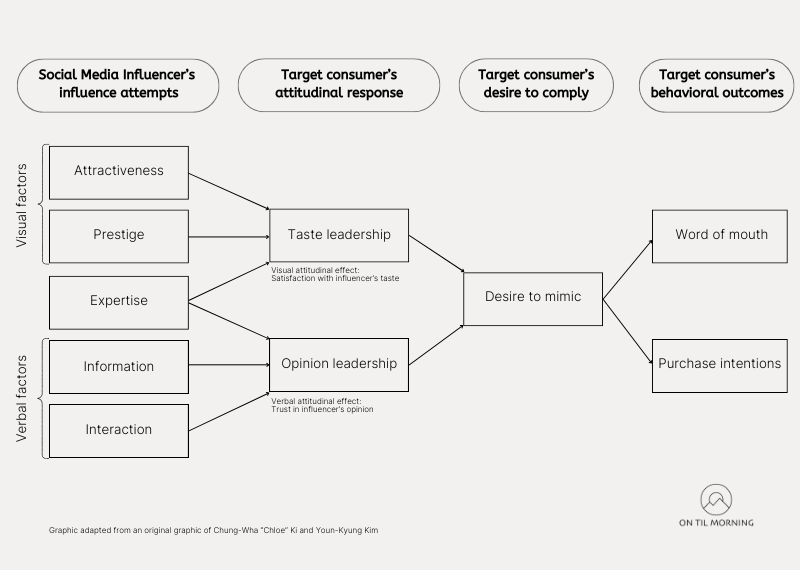
The Science of Influence:
How Social Media Influencers Shape Consumer Behavior
In the digital age, social media influencers have emerged as powerful figures in marketing, able to sway consumer decisions through their content. But what lies beneath their ability to influence millions of people? A study by Ki and Kim (2019) unpacks the mechanisms behind influencer marketing, offering valuable insights for businesses and individuals alike.
The Four Stages of Influence
- Influence Attempts: Social media influencers craft content that is visually attractive, prestigious, expert-driven, informative, and interactive.
- Attitudinal Response: Consumers evaluate the influencer as either a taste leader (someone with a strong aesthetic sense) or an opinion leader (someone who provides valuable advice and insights).
- Desire to Comply: Positive attitudes towards the influencer translate into a conscious desire to mimic their behaviors, choices, and style.
- Behavioral Outcomes: This desire results in actions like sharing posts (social media word-of-mouth) and purchasing endorsed products.

Mimicry in Consumer Decisions
A groundbreaking aspect of this research is the emphasis on mimicry. Consumers don’t just follow social media influencers for entertainment—they consciously imitate their lifestyles. This “desire to mimic” is the bridge between admiration and action. Whether it’s adopting fashion trends, trying new products, or even mirroring an influencer’s habits, mimicry significantly drives purchase intentions.
Key Traits of Effective Influencers
The study highlights several characteristics that make an influencer impactful:
- Visual Appeal: Attractive and aesthetically pleasing content boosts the perception of the influencer as a taste leader.
- Expertise: Demonstrating deep knowledge in a niche helps establish credibility as both a taste and opinion leader.
- Interaction: Engaging directly with followers fosters trust and builds stronger connections.
- Informative Content: Sharing detailed and valuable information enhances the influencer’s role as an opinion leader.
Takeaways for Brands
- Partner with the Right Influencers: Look for social media influencers whose content aligns with your brand’s aesthetic and values. A combination of taste and opinion leadership can amplify your message.
- Focus on Authenticity: Consumers trust influencers who are genuine and relatable. Authentic content can create deeper connections.
- Encourage Interaction: Influencers who engage with their audience—through comments, replies, and Q&A sessions—enhance trust and influence.
Future Implications
As influencer marketing evolves, the principles uncovered in this study will remain relevant. Brands that understand the science of influence can craft strategies that resonate deeply with consumers, turning admiration into action.
By leveraging the insights from Ki and Kim’s research, businesses can navigate the influencer landscape with precision, creating campaigns that not only capture attention but drive meaningful results.
Reference
Ki C‐W‘C’, Kim Y‐K. The mechanism by which social media influencers persuade consumers: The role of consumers’ desire to mimic. Psychol Mark. 2019;36:905–922. https://doi.org/10.1002/mar.21244
